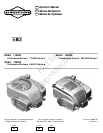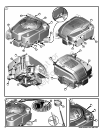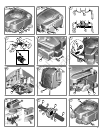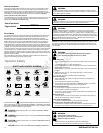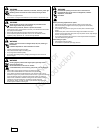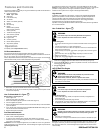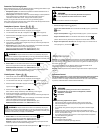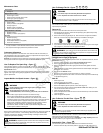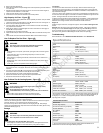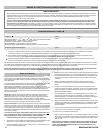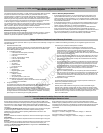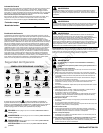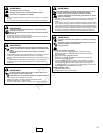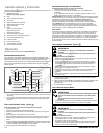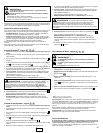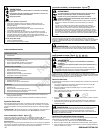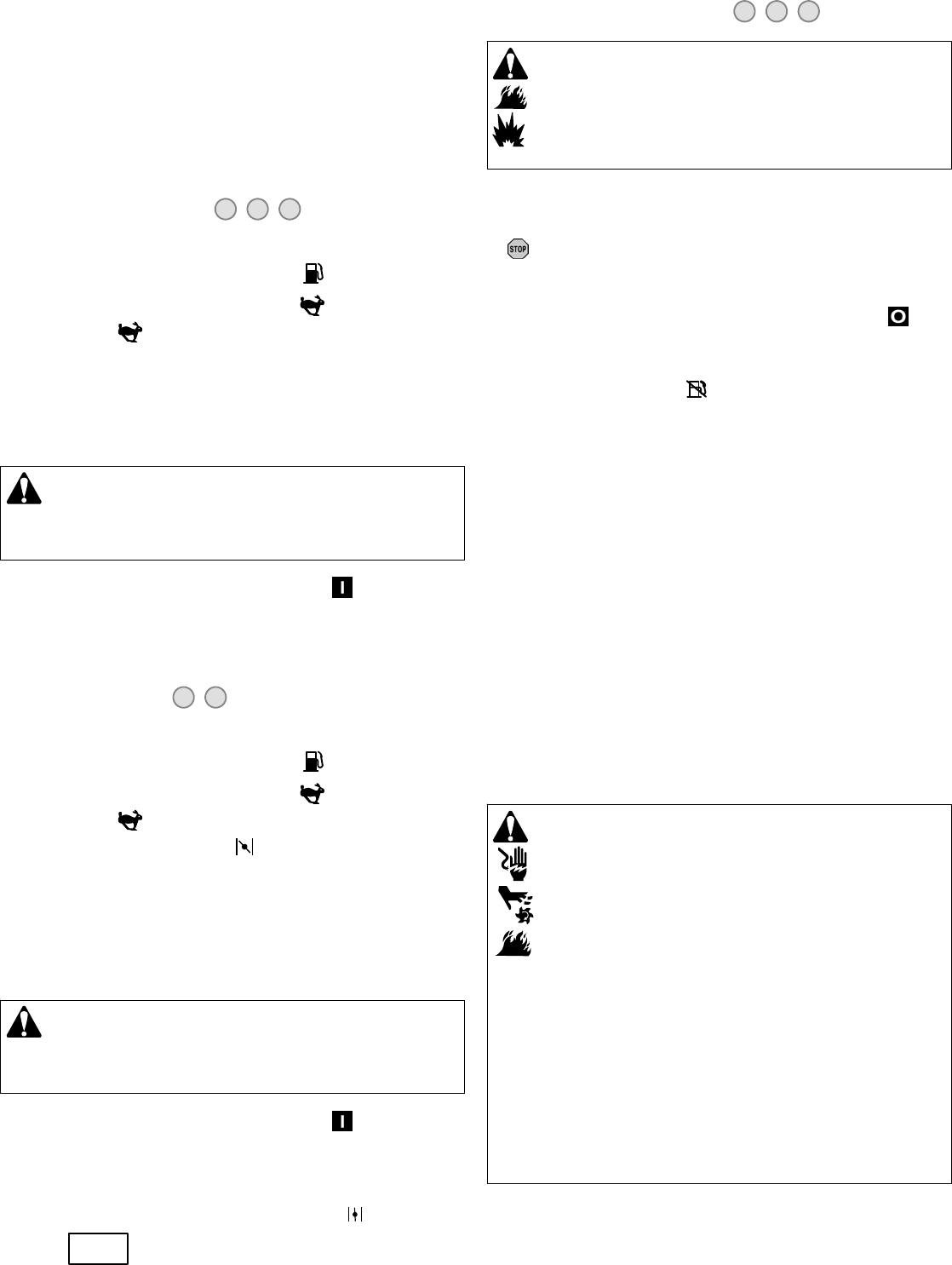
7
en
Determine The Starting System
Before startingthe engine, youmust determine thetype of starting systemthat ison your
engine. Your engine will have one of the following types.
ReadyStart
®
System: This features a temperature controlled automatic choke. It
does not have a manual choke or a primer.
Choke System: This features a choke to be used for starting in cool temperatures.
Some models will have a separate choke control while others will have a
combination choke/ throttle control. This type does not have a primer.
To start your engine, follow the instructions for your type of starting system.
Note: Some engines and equipment have remote controls. See the equipment manual
for location and operation of remote controls.
ReadyStart
®
System - Figure
4 5 6
1. Check the oil level. See the How To Check/Add Oil section.
2. Make sure equipment drive controls, if equipped, are disengaged.
3. Turn the fuel shut-off valve (A), if equipped, to the on
position (Figure 4).
4. Move the throttle control (B), if equipped, to the fast
position. Operate the
engine in the fast
position.
5. Push the stop switch (G), if equipped, to the on position (Figure 4, 5).
6. If the product is equipped with an engine stop lever (C), hold the engine stop lever
against the handle (Figure 6).
7. Rewind Start: Firmly hold the starter cord handle (D). Pull the starter cord handle
slowly until resistance is felt, then pull rapidly (Figure 4).
Note: If the engine does not start after repeated attempts, go to
BRIGGSandSTRATTON.COM or call 1-800 -233-3723 (in USA).
WARNING: Rapid retraction of the starter cord (kickback) will pull your
hand and arm toward the engine faster than you canlet go. Broken bones, fractures,
bruises or sprainscould result. When startingengine, pull the startercord slowly until
resistance is felt and then pull rapidly to avoid kickback.
8. Electric Start: Turn the electric start switch to theon/start position.
Note: If the engine does not start after repeated attempts, go to
BRIGGSandSTRATTON.COM or call 1-800 -233-3723 (in USA).
NOTICE: To extend the life of the starter, use short starting cycles (five seconds
maximum). Wait one minute between starting cycles.
Choke System - Figure
4 6
1. Check the oil level. See the How To Check/Add Oil section.
2. Make sure equipment drive controls, if equipped, are disengaged.
3. Turn the fuel shut-off valve (A), if equipped, to the on
position (Figure 4).
4. Move the throttle control (B), if equipped, to the fast
position. Operate the
engine in the fast
position.
5. Move the choke control (E) to the choke
position.
Note: Choke is usually unnecessary when restarting a warm engine.
6. Push the stop switch (G), if equipped, to the on position.
7. If the product is equipped with an engine stop lever (C), hold the engine stop lever
against the handle (Figure 6).
8. Rewind Start: Firmly hold the starter cord handle (D). Pull the starter cord handle
slowly until resistance is felt, then pull rapidly (Figure 4).
Note: If the engine does not start after repeated attempts, go to
BRIGGSandSTRATTON.COM or call 1-800 -233-3723 (in USA).
WARNING: Rapid retraction of the starter cord (kickback) will pull your
hand and arm toward the engine faster than you canlet go. Broken bones, fractures,
bruises or sprainscould result. When startingengine, pull the startercord slowly until
resistance is felt and then pull rapidly to avoid kickback.
9. Electric Start: Turn the electric start switch to theon/start position.
Note: If the engine does not start after repeated attempts, go to
BRIGGSandSTRATTON.COM or call 1-800 -233-3723 (in USA).
NOTICE: To extend the life of the starter, use short starting cycles (five seconds
maximum). Wait one minute between starting cycles.
10. As the engine warms up, move the choke control (E)totherun
position (Figure 4).
How To Stop The Engine - Figure
4 5 6
WARNING
Fuel and its vapors are extremely flammable and explosive.
Fire or explosion can cause severe burns or death.
Do not choke the carburetor to stop engine.
1. Release the engine stop lever (F, Figure 6)
or
Engine with Throttle Control: Move the throttle control (B, Figure 4, 5) to the stop
position
or
Engine with Stop Switch: Push the stop switch (G, Figure 4, 5) to the off position
or
Engine with Electric Start: Turn the electric start switch to the off/stop
position. Remove the key and keep in a safe place out of the reach of children.
2. Engine with optional Fuel Shut-off: After the engine stops, turn the fuel shut-off
valve (A, Figure 4, ) to the closed
position.
Maintenance
NOTICE: If the engine is tipped during maintenance, the fuel tank must be empty and
thesparkplugsidemustbe up. If thefuel tank is not emptyand if theengine is tipped in
any other direction, it may be difficult to start due to oil or gasoline contaminating the air
filter and/or the spark plug.
We recommend that you see any Briggs & Stratton Authorized Dealer for all
maintenance and service of the engine and engine parts.
NOTICE: All the components used to build this engine must remain in place for proper
operation.
Emissions Control
Maintenance, replacement,or repair of theemissions control devices andsystems
may be performed by any non-road engine repair establishment or individual.
However, to obtain “no charge” emissions control service, the work must be performed
by a factory authorized dealer. See the Emissions Warranty.
Unintentional sparking can result in fire or electric shock.
Unintentional start-up can result in entanglement, traumatic
amputation, or laceration.
Fire hazard
WARNING
Before performing adjustments or repairs:
Disconnect the spark plug wire and keep it away from the spark plug.
Disconnect battery at negative terminal (only engines with electric start.)
Use only correct tools.
Do not tamper with governor spring, links or other parts to increase engine
speed.
Replacement parts must be of the same design and installed in the same
position as the original parts. Other parts may not performas well, may damage
the unit, and may result in injury.
Do not strike the flywheel with a hammer or hard object because the flywheel
may later shatter during operation.
When testing for spark:
Use approved spark plug tester.
Do not check for spark with spark plug removed.
Not for
Reproduction



